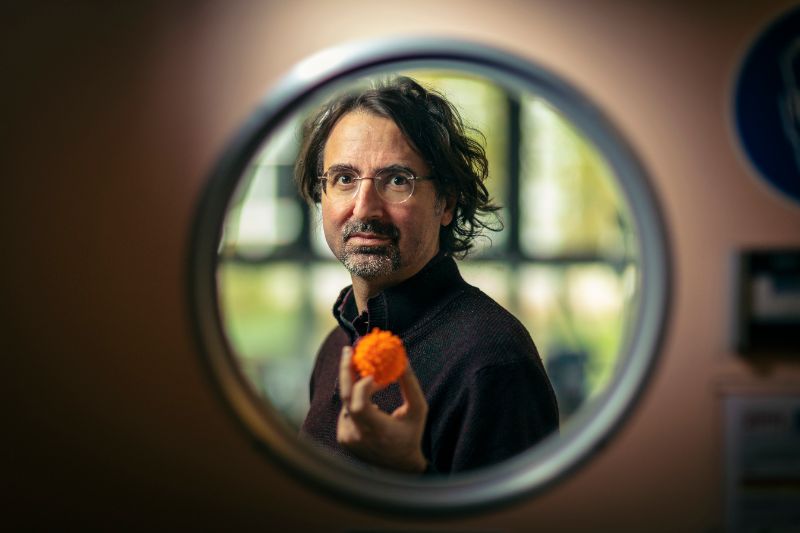Master key against viruses
When Francesco Stellacci talks about his research, every word is an expression of the enthusiasm of the professor who is the Head of the Supramolecular Nano-Materials and Interfaces Laboratory (SuNMiL) at the EPFL. He was born in Italy, and is thus always making gestures with his arms and hands when he speaks. As if this weren’t enough, in the interview he used items on his desk to help make his point. The cover of his AirPods represented the virus.
It’s all about viruses here, and not only since COVID-19 has been holding humanity hostage. Ten years ago, when Professor Stellacci came from the Massachusetts Institute of Technology (MIT) to EPFL, the materials scientist wanted to research ways of helping people in need. He initially started looking for a medicinal product to treat viral diarrhoea, an illness which kills thousands of children every year in developing countries.
Infectious diseases, both viral and bacterial, are one of the leading causes of death in developing countries. However, in the pre-COVID-19 era, the lion’s share of medical research funding went towards cancer or Alzheimer’s research. There was virtually nothing left over for infectious diseases – and the larger of the two small remaining pieces of the pie went towards research into bacterial diseases. Viral infections were the Cinderella of research. Therefore, Professor Stellacci became convinced that he should expand his project on a larger scale. It was now about finding a single killer for a large number of viruses. He substantiates his claim by saying: “Since the 1970s, we have been confronted with a new virus roughly every four years: HIV, Ebola and Zika.” Today, we have COVID-19. There is no doubt in his mind that it will continue like this and that the pace will even pick up. In the 1950s, there were about two billion people in the world. Today, there are more than 7.5 billion of us, and this figure is expected to rise to 10 billion in thirty years from now. Since population density is a decisive factor in how quickly viruses can spread, it is possible to draw a logical, simple conclusion: in 2050, the risk of a new virus breaking out will be five times as high as it was a century beforehand.
Therefore, it wasn’t about focussing on eradicating a single species of virus, but rather the pathogen’s genus itself. There simply had to be a way of developing a medicinal product, which renders every type of virus permanently harmless before it has the chance to penetrate the human cell via the cell membrane. After Professor Stellacci had ploughed through the scientific literature, it became clear to him that this possibility already existed. Put simply, sugar molecules – which also exist on the surface of cells where they exchange proteins – can attract viruses and the pathogen thinks it is in front of a cell. A clever ploy: they are merely sugar molecules. This method already produced some lasting successes in test tubes quite some time ago, albeit not in living creatures.
Whereas there are stable conditions in a test tube, in living organisms the protection of free-flowing sugar
molecules falls by the wayside as soon as concentration levels drop. The virus is then still there, the cell
is defenceless, and the infection cannot be avoided. Professor Stellacci looks at this problem through the eyes of a nano-material researcher, who studies many different effects on surfaces and knows that certain processes can become irreversible once they reach an advanced stage. For the virus in the body, this means finding a way to make it ‘explode’. Professor Stellacci now picks up his AirPods cover with his left hand. He drums the fingers of his right hand on it, as if he wanted to make it burst. This is exactly what it is all about. His medicinal product puts the virus under increasingly severe stretching pressure until it bursts like a balloon – at that moment, the virus is rendered permanently harmless.
He has already successfully tested the medicinal product on mice. “But,” he says, spreading his arms out wide, “there is still a long way to go.” With research funding from the Werner Siemens Foundation, he is now able to start the comprehensive studies needed to reach the clinics with his compounds. He is convinced that his master key against viruses should be able to protect the young, healthy section of the population when the next pathogen emerges. In the form of a nasal spray, this new drug could prevent a shutdown or lockdown. However, this medicinal product will even be so effective that it can make the virus harmless across the whole population. Realistically, the role of such a drug will be to give us some time until a vaccine has been developed.
Annual Report 2020
This article was prepared as part of the ETH Board's Annual Report 2020 on the ETH Domain.
